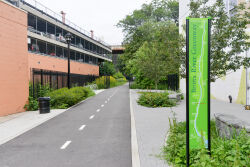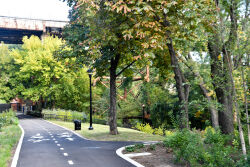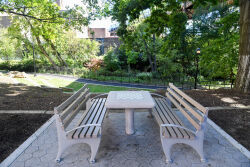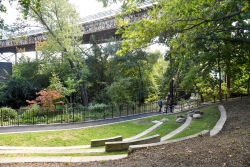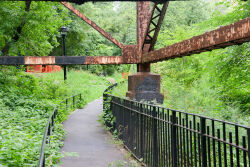West Farms Rapids
The Daily Plant : Tuesday, February 6, 2007
Bronx River Forest Is The Park Of The Month
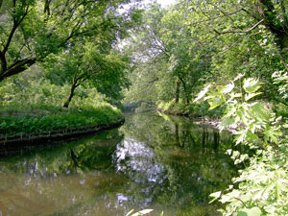
Photo courtesy of the Bronx River Alliance
Parks & Recreation has named the Bronx River Forest, a recently restored, little-known gem situated along the Bronx River, as Park of the Month for February 2007. The forest is a vestige of one of the few remaining old-growth forests and functioning floodplains in all of New York City. The unique landscape is located in a wide, flat section of the Bronx River Valley in an area that is bounded by the Duncomb Bridges to the north, Kazimiroff Boulevard to the south, the Bronx River Parkway to the east, and Webster Avenue to the west.
“The Bronx River Forest is one of New York City’s greatest ecological treasures,” said Commissioner Benepe. “It is a spectacular natural setting and a serene oasis situated amid the hustle and bustle of an urban environment. A recent $3 million capital restoration project led by Parks’ Natural Resources Group, as well as ongoing conservation efforts of the Bronx River Alliance, have dramatically transformed the forest to be more ecologically sound as well as visitor friendly.”
The forest is a natural playground for pedestrians and bicyclists alike, boasting a nature trail that loops through the forest and Burke Bridge, a newly renovated scenic lookout affording beautiful views of the Bronx River. Interpretive signage will soon be installed throughout the forest to enhance the visitor’s experience and provides an explanation of the forest’s ecology.
Besides offering aesthetic beauty, the Bronx River Forest serves a vital ecological function to the 23-mile river, acting as a natural floodplain. A floodplain is a low, flat, periodically flooded area of land located adjacent to a river and is created as a result of the river depositing, eroding, and re-depositing sediment over time. The Bronx River Forest floodplain provides a natural habitat for the river; stores and slows floodwater and traps sediment, thereby acting as a natural filter and reducing downstream scour, flooding, and sediment deposition; helps improve water quality of the river; and replenishes the river during dry periods.
In June 2005, Parks completed a $3 million capital restoration project in the forest, focusing on reconnecting the river to the floodplain, increasing in-stream habitat structures, controlling invasive plants, and re-establishing native vegetation. With funds from Mayor Bloomberg and a New York State Clean Air/Clean Water Bond Act, Natural Resources Group led the project and restored important functions of the floodplain by removing sediment deposits on the banks, increasing its ability to store and filter floor water, and enhancing natural habitat. The restoration also improved access to the area by upgrading the greenway path and nature trails, and adding boardwalks and overlooks to provide year-round access to the restored areas.
The Bronx River is believed to be a pre-glacial stream whose course has been reshaped and modified over time. The Bronx River Forest is a remnant of what was previously a thickly-forest region in the river valley. The forest has served as a natural floodplain to the river for thousands of years. Today, the forest is home to more than 250 thriving species of native flora such as pin oak, river birch, and white snakeroot, and native fauna, including the mallard, common merganser, and muskrat.
Throughout the year, free nature walks, volunteer clean-ups and plantings, and educational tours are held in the Bronx River Forest. In addition, within the forest there is a boat launch on the east bank of the river that may be used as a launch site for canoes and kayaks.
THIRTEEN YEARS AGO IN THE PLANT
(Friday, February 4, 1994)
On this day in 1869, John Quincy Adams Ward’s bronze statue The Indian Hunter was dedicated in Central Park. The first sculpture by an American to be placed in the park, it won Ward (1830 – 1910) immediate recognition as one of the leading sculptors of his day.
QUOTATION FOR THE DAY
“Skeptical scrutiny is the means, in both science and religion,
by which deep insights can be winnowed from deep nonsense.”
Carl Sagan
(1934 – 1996)
Check out your park's Vital Signs
Clean & Safe
Green & Resilient
Empowered & Engaged Users
Share your feedback or learn more about how this park is part of a
Vital Park System


